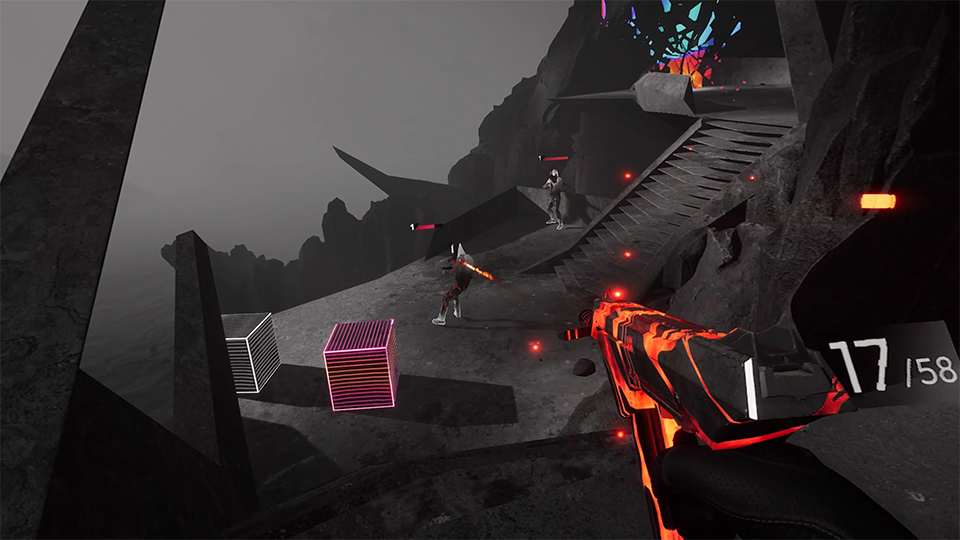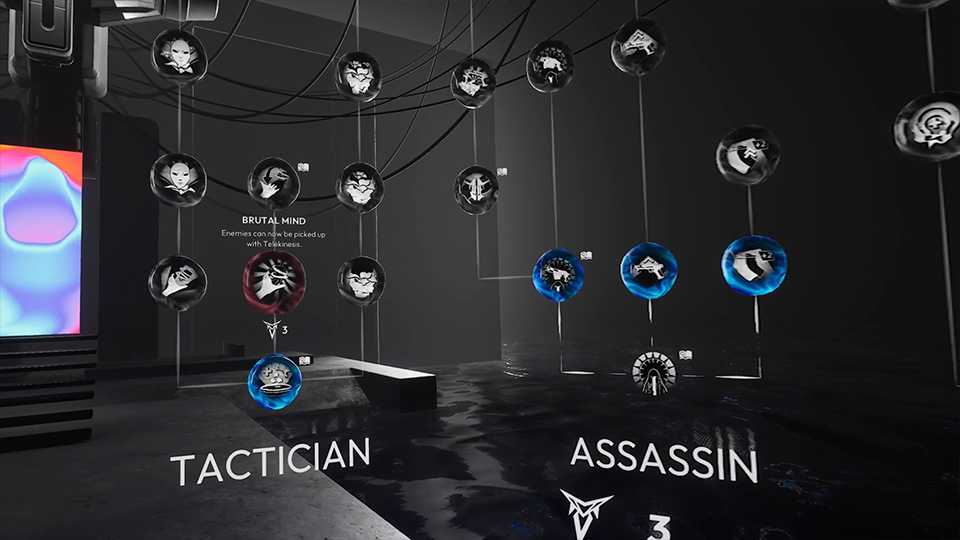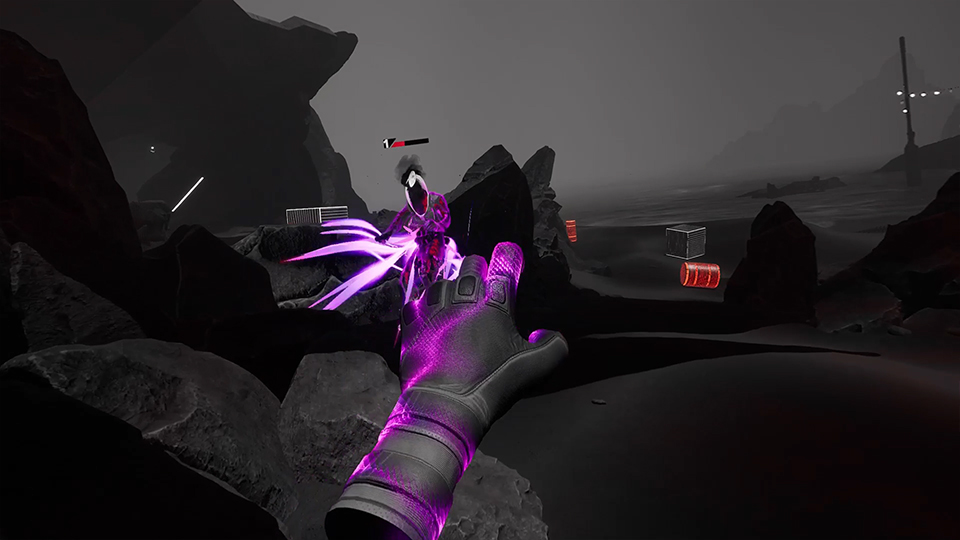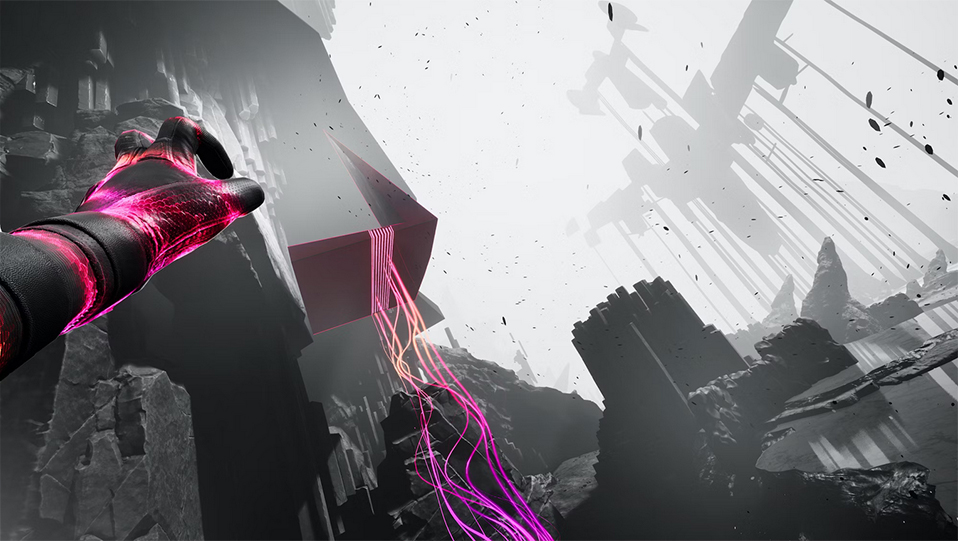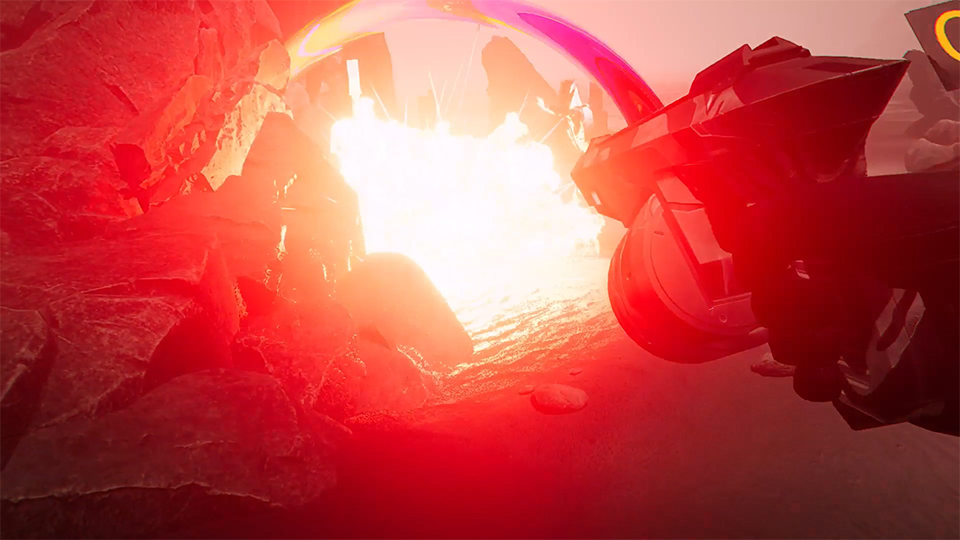Developer / Publisher – nDreams
Price – US $29.99 / CAN 34.99 / EU €29.99 / UK £22.99
Release Date – July 4th, 2023
Input – 2 x Motion Controllers
Play Area – Seated, Standing
Store Links – PlayStation
Reviewed on – PSVR 2
Synapse is a rogue lite shooter from the minds over at NDreams that made me feel like John Wick with force powers. And no, that’s not just YouTuber-style click bait propaganda, it really is that cool. A PSVR 2 exclusive, Synapse is uniquely designed to take full advantage of PSVR 2’s eye tracking capabilities and dual sense controllers. This is a VR game that could currently only be possible on the PSVR 2 headset, and I’m calling this must own VR for anyone who loves shooters and Rogue lite game loops, so stick around and I’ll tell you why.
In the world of Synapse, Colonel Peter Conrad and his Consortium have planned a devastating world ending biological attack. Your operative group has tracked him down, but the details of his plan are still unknown. You enter into his mind, Animus-style, on a mission to reach deep into his subconscious and attempt to uncover the secrets of his plan and take him down. Of course, you are not a welcome guest in his head, and as such he fights back with an assortment of conjured up enemies bent on eradicating you.
Synapse is through and through a Rogue lite and your attack into Conrad’s mind is broken up into 3 primary sections. The first section is Conrad’s preconscious which itself consists of 3 stages concluding with a sub boss fight that isn’t easy. Next up is his conscious mind which also consists of 3 levels and another sub boss that kicked my ass. Finally, the last stage is Conrad’s subconscious and the final boss fight is against the man himself. Now this might not seem like a long game, and you might think you are in for a short 2 to 3 hour campaign like NDreams last PSVR exclusive Fracked, but in true Rogue Lite fashion, love it or hate it, Synapse is going to take players somewhere between 8 and 12 hours to complete. Thankfully levels here are handcrafted, so you won’t be feeling that generic quality to the level designs that so many rogue lites suffer from. To keep things fresh, enemy placements and various power up stations (shrines) do change, so while you can memorize map layout, you won’t be able to simply walk through stages on auto pilot.
As expected, you start out in Synapse pretty weak. Armed with only a handgun, a handy mini map and your basic telekinesis powers, you’re likely to get your ass kicked after only a few levels. Enemies come in a combination of those who populate certain parts of a stage as well as additional waves that will spawn in random locations to continue the fight. These spawns, when combined with the fact that some enemies can teleport, meant I was always on the move, rarely just hiding behind cover. In fact, Synapse seems to have been developed specifically to encourage player movement and finding a combat flow. Downed enemies have a chance to drop ammo and something the game calls Defiance. Defiance is essentially your in-game currency and allows you to buy certain character buffs in addition to health and ammo at shrines found randomly in the game’s stages. Defiance and purchased shrine upgrades only last for the duration of your current run and are lost upon death. However, not all is lost, as Synapse has a vast number of in-game achievements connected through a sort of upgrade tree. Active achievements are shown in the game’s pause menu so you can track your progress during a run. When completed they can be redeemed in the game’s staging areas prior to a run and then be used as upgrade points to spend on permanent player upgrades that will significantly boost your capabilities and your chances for survival. Upgrades are split up into 3 categories, that of Survivor, Assassin and Tactician. Tactician is your telekinesis powers, and consequently the part of Synapse that truly takes the game from simply just another typical rogue lite and makes it truly something special.
The gunplay here is also fantastic, and if you played NDreams prior title, Fracked, than you will have a pretty good idea of what to expect. Ndreams have taken the best parts of Fracked – its fast and fluid gunplay and slick cover mechanics – and leveled them up for next gen hardware and analog sticks. Just like Fracked, cover is taken by physically grabbing the world and pulling, giving players a real dynamic sense of control in how they take cover. Click turning is an option for those who don’t do smooth turning, but running and moving quickly are staples in Synapse, so know that going in if you don’t yet have your VR legs. New weapons can be picked up at weapon shrines scattered around certain levels and offer players a choice between 2 different weapons, which often include a higher level version of the one they have currently equipped. Weapons on offer besides the standard starting pistol consist of a submachine gun, shotgun and grenade launcher, all of which must first be unlocked in the assassin upgrade tree before they can appear in the game world. All of these guns felt awesome in their own right with reloads being done by slamming in the mag with your hand, your body, or even the environment. In addition each weapon lends itself to a different type of attack style and allows players to attack the game the way they want. For example the shotgun is powerful up close but weak at range, meaning players must engage in some close quarters combat and often rely more heavily on their telekinesis powers to bridge those distances. The hand gun can be used more at range, favoring those who want to rely more on simple gunplay. Similarly the submachine is a shooter’s paradise, but burns through precious ammo. Finally, the grenade launcher can be devastating with its area of damage, but can be lethal to players when shooting close quarters, making telekinesis a must. Ammo conservation matters here and can’t be wasted. Weapons feel powerful, balanced and often gave me some strong John Wick vibes as I powered through levels dropping enemies like a boss. However, your Telekinesis powers (especially once they are leveled up a bit) essentially make you feel like John Wick with Jedi Force powers, and that my friends is why I love VR so much. Synapse simply couldn’t be done as a flat game, and honestly probably not on any other current VR headset either.
Taking advantage of the PSVR 2’s eye tracking capabilities to track what you are looking at in the game world, the end result is that Synapse seems to almost intuitively know what you want to grab with your telekinesis. It isn’t always perfect, but it’s damn close and made running through stages an absolute blast. In Synapse’s black and white dream world, items that glow can be picked up and tossed about using the games great physics engine, with barrels being especially fun as the games use of the dual sense haptics triggers allows players the option of picking them up with a soft lock on the trigger, then pulling it all the way tight to crush and detonate it. Further upgrades to Telekinesis opens up the ability to pick up and throw enemies as well as grenades they throw at you, and it is at this point that you begin to feel like a god. Remember that scene at the end of Rogue One when Vader just decimates the incoming forces….yeah, I felt like that. Of course, in addition to feeling like a total badass, Telekinesis also opens up a ton of movement and combat possibilities and essentially turns your runs through Synapse into a giant playground of carnage; and when combined with an upgrade system that truly makes you feel more powerful, Synapse definitely got it’s hooks into me, and had me going…just one more round.
Visually, Synapse is a beautiful game. I will admit that I do think the chosen black and white art style can make the game’s stages feel a little basic at times, especially when contrasted between the game’s opening moments in the full color real world. That being said, as I acclimated to the game’s art style I began to appreciate the level of detail that was present, and the way in which the game uses color. Running on Unreal Engine 5, Synapse uses ray tracing techniques to fill the world with some amazing lighting and reflections, and does so with an almost endless draw distance and razor sharp resolution in the headset. Yes, the game unfortunately does use reprojection here, but while it’s noticeable if you’re looking for it, the black and white nature of the game makes it much less noticeable than other titles using it. Of course, not everything is black and white. In a similar method to Superhot, what can be interacted with is instantly communicated to players through a simple pop of vibrant colour in a black and white world. Think of the Sin City movies and how they used color and contrast to make things pop and you’ll get the idea. Here in VR this technique is magnified tenfold, and while I’m not sure if it would have been my art style of choice, it certainly makes for a unique gameplay experience that needs to be played to fully appreciate.
Audio-wise, Synapse also does an excellent job, offering up some of the best 3D audio design I’ve heard in a VR game in quite some time. One of my issues with Hubris was that enemies never made a sound, until they were actually shooting at you. While that may actually be more true to real life, it often makes for bad video game design. In Synapse, enemies love to talk shit, threatening to kill you, ordering others to attack and are generally pretty vocal, yelling when picked up and thrown, and even pleading for their lives at times. This may not sound super unique on paper, but while playing Synapse I realized how many VR games in recent memory completely ignore this part of audio design. I’m sure this is a cost saving move, but it really makes for a more lively experience, as well as being a very useful tool for players to track enemy movements they may not see. Oddly enough though, Synapse has chosen to almost entirely forgo any music while in the combat stages. I didn’t really miss it though and actually had to go back and check my footage when writing this review to even remember if it was there. One area Ndreams definitely didn’t pinch pennies on was the voice talent they chose. Going total A-list here in Synapse, they have enlisted the talents of Jennifer Hale of Bioshock, Mass Effect and Metal Gear Solid fame. Jennifer plays the role of your in-ear handler, and while woefully underutilized here, she is a welcomed and familiar video game voice. Speaking of Metal Gear Solid, NDreams got the Solid Snake himself, Mr David Hayter, to voice Colonel Peter Conrad. Hayter is one of the best in the business and absolutely nails his role here as the Synapse baddy. Finally: gun sounds. Of course, to me they could always be louder, beefier and more aggressive, but nevertheless guns are handled well here, giving gunplay a great tactile feel to my ears that complimented the excellent haptics in the controllers.
Now to final thoughts and review score. As a PSVR 2 exclusive, Synapse is the game PSVR 2 really needed right now. This is a game that literally couldn’t be played on any other current mass market headset, as it takes full advantage of the PSVR 2 unique features such as eye tracked gameplay, dynamic foveated rendering, and complete use of the dual sense controllers and head haptics, not to mention the power of the PS5. Often feeling like a game Sony themselves might have developed to highlight their new piece of tech and the visual capabilities of the PS5, Synapse will most definitely make players happy they bought the headset. Thankfully though, Synapse isn’t just bells and whistles, but offers up some of the most fun I’ve had in VR since the PSVR 2 first launched. That being said, this is a Roguelite through and through, so know that going in. I think Synapse is going to really surprise people – even those who are tired of Roguelites – as it is easily some of the most fun you can have in VR in 2023, and a must own for fans of shooters and roguelites.
nDreams provided The VR Grid with a press code for this title and, regardless of this review, we thank them for that!


